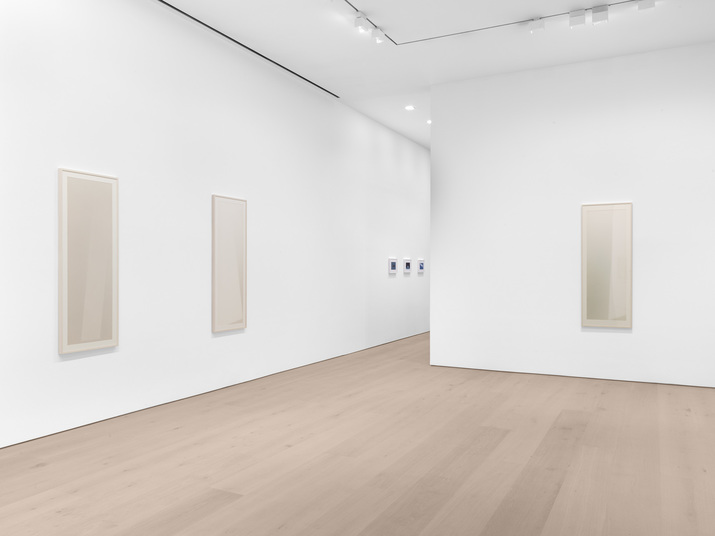-
From Current Issue
-
- Editor’s Letter Fire in the Heart
- Reviews I Gusti Ayu Kadek Murniasih
- Reviews 11th Seoul Mediacity Biennale: “One Escape at a Time”
- Dispatch Networked China
- One on One Monira Al Qadiri on Yukio Mishima
- Essays The rise of independent art spaces in pandemic-era Shanghai
- Features Tuan Andrew Nguyen
- Table of Contents
- Web Exclusives
- Archive
- Subscribe

R
E
V N
E
X
T
CHING HO CHENG, Chemical Garden, 1970, gouache and ink on rag board, 76.2 × 76.2 cm. All images courtesy the Estate of Ching Ho Cheng and David Zwirner, New York.
Seventeen paintings, from different periods in Ching Ho Cheng’s career, were displayed on the second floor of David Zwirner at West 20th Street. Curated by Simon Wu, the exhibition was simple yet effective. People wandered through its spacious rooms, admiring the works neatly hung on white walls, carefully spaced out from one another. Two paragraphs of wall text provided patrons with the show’s context. They sketched the artist’s biography, described Wu’s first visit to Cheng’s apartment at the Chelsea Hotel last spring, and offered a brief interpretation of the “spiritual interconnectedness” and profundity of everyday objects that the artworks convey—but that was it. There were no labels identifying individual pieces nor any supplementary handouts at the reception desks. Viewers were left to experience the art and the art alone, which effectively went hand in hand with the show’s contemplative tone and the deep concentration that the works elicit.
First seen when entering the exhibit, Miss Destiny (Spider Painting) (1976) is a striking gouache and ink depicting a black spider resting slightly off-center on an intricate web. Over a blue background and white flecks of stars, the spider is outlined in a glossy white, making its segmented three-part body stand out—especially its deity-like head and headpiece, which echoes Cheng’s interest in Tibetan art. Miss Destiny suggests a serendipitous encounter, as one’s gaze unwittingly sets upon the spider perched on its web but is drawn to linger with how it is set aglow against the starry night. Its poetic simplicity recalls a childlike innocence evocative of Charlotte’s Web while connecting the mundane with the cosmic, with a sensibility that is identifiably Cheng’s.
A transitional work, Miss Destiny, contains the spirituality and enlightened perception of Cheng’s earlier paintings as well as the minimalist aesthetic of his later pieces. Sectioned off in different rooms, the show featured these periods, too. One room presented two paintings from his early psychedelic efforts: Chemical Garden (1970) and The Astral Theatre (1973–4). Displayed exclusively on one wall, Chemical Garden is a maximalist painting, with every inch of the 30-by-30 rag board wriggling with color and activity. Two overlapping squares brimming with green, pill-shaped and neon blue, worm-like cells frame a large red intestine that surrounds a smiling face, whose toothy grin is reminiscent of Lewis Carroll’s Cheshire cat. At the bottom, radiating out of the intestine, are luminous red sperm that transform into big paisley patterns as they reach the top of the composition. Here, Cheng calls attention to the vitality of physiology, down to a molecular level.
With its hallucinatory imagery, Chemical Garden exudes the 1970s counterculture within which it was made. Around that time, Cheng lived in a SoHo loft and absorbed the art scene in downtown New York, often frequenting the Max’s Kansas City nightclub where many creatives gathered. Yet amidst the trippy visuals are ideas that would manifest throughout Cheng’s oeuvre: corporeal and cosmic interconnections brought on by mind-altering, perception-heightening drugs suggested by Chemical Garden, and a focus on the minuscule, expressed in Cheng’s later works as windows—thresholds that tie domestic spaces to the outside world.
The following room saw Cheng’s approach shift after moving to the Chelsea Hotel in 1976 where he began painting the slices of sunlight that seep into the windows of his apartment. These abstract, often untitled, gouache paintings merely consist of shapes, light, and shadow, but they are some of his best work. Untitled (Windows) (1983), found in the largest room at the back of the gallery, is two-toned like the rest of the series. Stepping back, the imperceptible blending of light and dark beiges captured on the canvas resembles sunlight shining through a window at noon. Contemplative with their muted colors, his window paintings once again sees Cheng finding the sublime in the mundane.
David Zwirner’s exhibition is a part of a larger series, “More Life,” in conjunction with the fortieth anniversary of the HIV/AIDS crisis, which took Cheng’s life in 1989. This retrospective attests to the practice of a talented artist that, though regrettably cut short, continuously mutated and morphed in ways that offered viewers a closer and different look at the mutual link between everyday items deposited on this earth and the ineffable, sacred aura that they radiate.
“More Life: Ching Ho Cheng” was on view at David Zwirner, New York, until October 23, 2021.
To read more of ArtAsiaPacific’s articles, visit our Digital Library.














